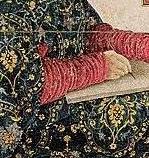|
Miller’s PortraitThe portraits in the Canterbury Tales General Prologue are often described as a cross section
or picture gallery of 14th century society. There is an indication in these phrases of the "enclosed frame" of each pilgrim's
description, introduced by the classic rubric of biography ‘the Miller was’ or ‘there was’. Yet this
formality implicit in the estates satire is here set against the disorganized piling up if detail, the ‘collusion of
impression from the collision of detail’ as Baldwin put it. Contrasted with the accepted description, Chaucer method
of contrapuntucal detail and jumping from ‘shinbone to cookery’ gives a suggestive, yet vivid picture. In this
passage, the Miller is described by build, beard, and a wart on his noseh, yet the ‘character’ is captured.
This
is further amplified by the paratactic syntax, putting things side by side without much comment, a steady cataloguing of ‘and’.
Everything is pulled together with the sense of what Baldwin calls the radix trait, in this case the Miller’s physicality,
as well as by a consistently detailed focus, as though the narrator is looking through a magnifying glass – we see the
hairs on the ‘werte’.
This naturalism is also clear in the similes, which Hazlitt described as acting
as an index pointing to the subject. In the Miller's portrait the external detail figured metaphorically by the spade, the
bristles on a sowe and the furnace all act as indicators of inner character and also link the figure with the tale he is to
tell, as the furnace with the smith.
The truthfulness seems at odds with the narrator’s naiveté, made clear in
the use of hyperbole. An example in htis passage is ‘wel koude he stele’ where as Hoffman says, the reader seems
to be tipped into the act of judging by the sense that if this seems reprehensible, there must be standard by which it appears
to be so. The "wel", in its incongruity, adds to the problems this line creates. Howard has argued that Chaucer-pilgrims wide-eyed
position is in fact a Christian one, stemming from what he argues is the profound irony of loving the man but hating the sin.
Here however, the ‘wel’ seems less a gullible readiness to love the sinner than a genial joke. As Donaldson points
out, the narrator does recognise rascals when they are in the lower classes, but at the same time seems to have a kind of
grudging admiration for efficient thievery.
Pearsall and Eberle have commented on Chaucer’s remarkable
lack of outrage toward the word of commerce, an ambivalence some have attributed to his ‘Janus like social position’
between the court and his own origins, and the narrator in a sense is given a degree of sophistication here, listing the fault
but seeing it as a virtue on a level with musical skill.
The bagpipes are obviously linked with the Miller’s
potency and indicate his knowledge of synne, but they are also, like the furnace, a link to his tale, where as Patterson says,
Nature is not only accepted but redeemed. This is most obvious in the scene where the ‘belle of luades’ harmonises
with Alisoun and Nicholas’s melodye. Music also links with what Lindahl sees as a central structural element in the
CT – the medieval festival which account for the emphasis on the group. Howard argued that the idea of serial progression
in the GP ought to be discarded, for the view that Chaucer is here presenting society in little, and that thus the GP is realistic
in detail, universal in depiction of group tendency and profoundly medieval in it’s recognition that ‘this world
is nat so strong’
There is a consistent carnivalesque element in the CT, which is at odds with the pilgrimage,
yet also an inevitable part of its dualistic focus as Bisson says. In the passage, it is notable that as opposed to ideal
pilgrims all the information we are given is external with four lines of qualities, none of which have any direct connection
with the ‘ful devout corage’ of going on pilgrimage.
Described in terms of bestiality, and with the
reference to the sowe, a very clear signal of connection with carnival, his disruptiveness indicated by the anecdotal evidence
given matter-of-factly that he uses his head not for rational thought but for breaking down doors.
|

